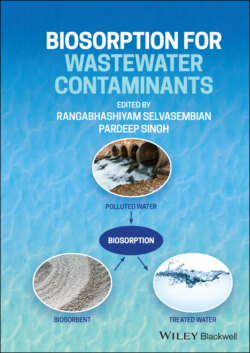Читать книгу Biosorption for Wastewater Contaminants - Группа авторов - Страница 36
Desorption and Regeneration
ОглавлениеThe ability of biosorbents to recover after use is one of their most important achievements. Adsorbate is cleared off the biosorbent surface after use, and the biosorbent reverts to its original structure and efficiency (Adewuyi, 2020).Biosorbents’ economic value and sustainability are primarily determined by the number of cycles they can be reused. It is essential to develop an effective desorption method. High performance is not enough for a biosorbent; it also needs to be reusable. As a result, when choosing biosorbents, desorption and regeneration are the important processes to consider. Still, some of them are difficult to regenerate, making their long‐term usage doubtful since they would need to be discarded after a few cycles. Disposing of such materials can result in contamination of the environment. The separation of spent biosorbents and the regeneration and recycling of the medium after the sorption process are very significant.
Eluent utilization is now the most frequently used desorption mechanism. Choosing the right eluent is essential and depends on the form of biosorbent, adsorbent, and biosorption mechanism. A proper eluent should not harm or modify the biosorbent structure, it should be environmentally friendly and affordable, it should have a high level of adsorbing ability, it should not alter adsorbing or biosorbing substances, and it must be easily disconnected. To dislodge metal ions while concurrently replenishing the filled biosorbent, chemicals like hydrochloric acid and sodium hydroxide and chelators like EDTA have been utilized (Ahemad and Kibret, 2013).
